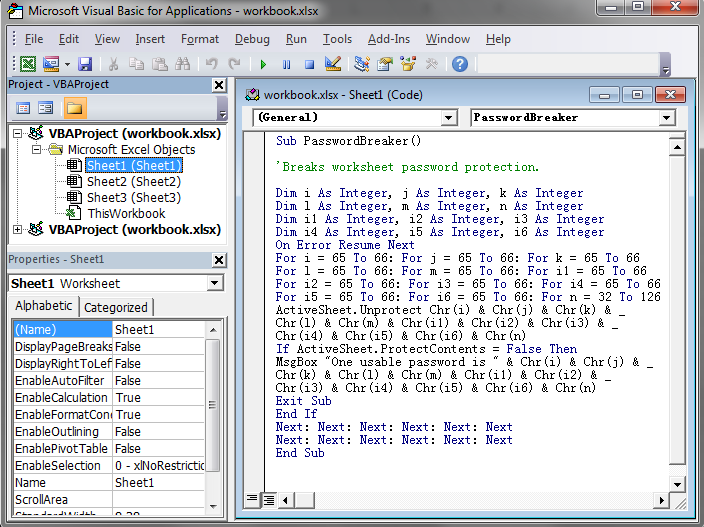5 Proven Methods to Unprotect Excel Sheet 2016 Without Password

Introduction to Password-Protected Excel Sheets

Password-protected Excel sheets serve as a fundamental security measure in Microsoft Excel, offering users a way to safeguard sensitive data or lock cells to prevent unintended changes. However, scenarios arise where you might need to access or modify a protected Excel sheet but lack the password. Whether due to forgotten passwords, inherited workbooks, or the need for data recovery, unprotecting an Excel sheet can become a critical task. In this comprehensive guide, we will explore five proven methods to unprotect an Excel sheet 2016 without a password, ensuring you can regain access to your valuable data or assist others effectively.
Method 1: Using the VBA Code

Visual Basic for Applications (VBA) is Excel's programming language that allows for extensive control over Excel functions. One of the simplest ways to unlock a protected sheet involves writing a VBA script.
💡 Note: Use this method only if you are permitted to modify the Excel file.
- Open the Excel Workbook: Open the Excel file containing the protected sheet.
- Open VBA Editor: Press 'Alt + F11' to open the VBA editor. You can also go to Developer Tab > Visual Basic, or press 'Alt + F11' if the Developer Tab isn't visible.
- Insert a New Module: Right-click on any object in the Project Explorer, select Insert > Module.
- Paste VBA Code: In the new module, paste the following VBA code:
Sub PasswordBreaker() Dim i As Integer, j As Integer, k As Integer Dim l As Integer, m As Integer Dim Pass As String On Error Resume Next For i = 65 To 66: For j = 65 To 66: For k = 65 To 66 For l = 65 To 66: For m = 32 To 126 Pass = Chr(i) & Chr(j) & Chr(k) & Chr(l) & Chr(m) ActiveSheet.Unprotect Pass If ActiveSheet.ProtectContents = False Then MsgBox "Password is " & Pass Exit Sub End If Next: Next: Next: Next: Next MsgBox "Could not find password" End Sub - Run the Macro: Close the VBA editor, press 'Alt + F8', select 'PasswordBreaker', and click 'Run'.
Method 2: Manual Password Cracking

This method involves manually trying various password combinations, although it’s less practical for complex passwords:
- Basic Logic: Start with common passwords like "password", "123456", "Excel", etc.
- Use Variations: Include numbers, special characters, or variations on the common passwords.
🔒 Note: This method is time-consuming and not suitable for heavily encrypted sheets.
Method 3: Using Excel Password Recovery Tools

When manual methods fail, software tools can assist in recovering or bypassing Excel passwords:
| Tool Name | Description | Compatibility |
|---|---|---|
| Excel Password Recovery Master | Can recover or remove Excel passwords | Windows, Excel 2010-2016 |
| iSeePassword | Removes Excel password in seconds | Multiple platforms including Windows and macOS |
| PassFab Excel Password Recovery | Three attack modes to recover password | Windows, Excel 2010-2019 |

To use these tools:
- Download and Install: Obtain the tool from a reputable source and follow the installation instructions.
- Open and Process: Launch the tool, select the protected Excel file, and initiate the password recovery process.
Method 4: Using Third-Party Services

Online services like LostMyPass or Password-Find offer password recovery as an online service:
- Upload File: Visit the service's website and upload your Excel file. Ensure it's secure and trustworthy.
- Recovery: Follow the on-screen instructions to recover or remove the password.
🔍 Note: Be cautious when using online services due to potential privacy concerns.
Method 5: Renaming and XML Editing

This method involves renaming the Excel file and editing its XML to remove protection:
- Rename File: Change the file extension from .xlsx to .zip.
- Extract: Extract the ZIP file to get access to the XML files.
- Edit XML: Open 'worksheet.xml' in the 'xl\worksheets' folder. Find '
' elements and either remove them or set 'sheetProtection' attributes to '0'. - Rename Back: Zip the files again and rename back to .xlsx.
After exploring these methods, remember:
- Understanding the importance of password protection and respecting data security is crucial.
- Unauthorized access to protected data is illegal and unethical. Always seek permission before attempting to bypass security measures.
- Effective backup strategies can prevent the need for these methods by ensuring important data is not lost or locked out.
Is it legal to unprotect an Excel sheet?

+
Unprotecting an Excel sheet without permission can be illegal and unethical, especially if it involves accessing confidential or proprietary information without authorization. Ensure you have the legal right to modify the file.
What should I do if I forget the password for my Excel sheet?

+
If you’re the owner of the sheet, try using the methods described above or use password recovery tools. If it’s someone else’s sheet, get their permission or contact the creator for assistance.
Can I prevent others from unprotecting my Excel sheet?

+
While you can’t entirely prevent someone from using tools or techniques to bypass sheet protection, you can enhance security by using strong, complex passwords, encrypting the workbook, and regularly backing up your work.



